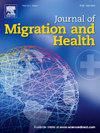Characterization of international migration movements toward Chile: A scoping review of scientific articles and official reports
IF 2.9
Q1 PUBLIC, ENVIRONMENTAL & OCCUPATIONAL HEALTH
引用次数: 0
Abstract
In the last decade, Chile has emerged as a receiving country for migrants from Latin America and the Caribbean (LAC). The scale of this phenomenon has sparked increasing interest in understanding its impact on various sectors such as healthcare and education. This study aims to characterize the scientific evidence and official reports on international migration toward Chile from 1990 to 2024. A scoping review was conducted. Global inclusion criteria: These encompassed articles and official reports published between 1990 and 2024 focusing on the migrant population toward Chile. Databases for the articles: These included PubMed, Scopus, WoS, and SciELO. Keywords: These included Transients and Migrants, Emigration and Immigration, Population Dynamics, Human Migration, Chile, South America, Latin America, and Freedom of Movement. Sources for the official reports: These included National Statistics Institute (INE for its acronym in Spanish); Department of Immigration and Foreign Services; Jesuit Migrant Service; National Human Rights Institute (INDH for its acronym in Spanish); and The UN Refugee Agency (UNHCR). No keywords were used. Global variables: These included type of study, sociodemographic characteristics, type of migration, object of study, main results, limitations, and conclusions. A concordance test of the questionnaire was conducted for the articles and official reports, yielding 91 % and 94 % agreement between observers, respectively.
Accordingly, 21 articles and 28 official reports were included. In both types of sources, the study population included the entire life cycle, primarily from countries in LAC. The observed types of migration included international (voluntary, forced, or humanitarian). Articles focused on measuring mental health (MH) and the access/use of healthcare services. Regarding MH, it was observed that the young migrant population exhibited worse indicators than the adult population, while both migrant and Chilean populations exhibited similar MH statistics, with socioeconomic level (SEL) being a significant determinant. Access to healthcare services has increased among the migrant population and is contingent upon SEL. Only two articles have addressed subjects related to reproductive health, with none discussing sexual health. Official reports focused on characterizing the population and their access to services (healthcare, education, housing, occupational situation), border mobility, poverty index, social perceptions, and inclusion. Most studies have utilized secondary data provided by official sources.
Migration toward Chile primarily involves south–south migration, sociodemographic characterization, and issues accessing services, including healthcare. Results highlight a scarcity of studies collecting primary data, leading to a lack of relevant indicators for understanding aspects such as migration causes, attracting factors, migration trajectory, migration status, cross-cultural relationships, or sexual health.
向智利迁移的国际特征:科学文章和官方报告的范围审查
在过去十年中,智利已成为拉丁美洲和加勒比移民的接收国。这一现象的规模引发了人们对了解其对医疗保健和教育等各个部门的影响的兴趣。本研究旨在描述1990年至2024年智利国际移民的科学证据和官方报告。进行了范围审查。全球纳入标准:这些标准包括1990年至2024年间发表的文章和官方报告,重点关注前往智利的移民人口。文章数据库:包括PubMed、Scopus、WoS和SciELO。关键字:这些包括瞬态和移民,移民和移民,人口动态,人类迁移,智利,南美,拉丁美洲和行动自由。官方报告的来源:包括国家统计局(西班牙语缩写为INE);移民和外交事务部;耶稣会移民服务处;国家人权研究所(西班牙语首字母缩写为INDH);以及联合国难民署(UNHCR)。没有使用关键字。全局变量:包括研究类型、社会人口特征、迁移类型、研究对象、主要结果、局限性和结论。对文章和官方报告进行问卷一致性检验,观察员之间的一致性分别为91%和94%。因此,列入了21条和28份正式报告。在这两种来源中,研究人群包括整个生命周期,主要来自拉丁美洲和加勒比地区国家。观察到的移徙类型包括国际移徙(自愿、强迫或人道主义)。文章的重点是衡量心理健康(MH)和获得/使用保健服务。关于MH,我们观察到年轻移民人口的指标比成年人口差,而移民和智利人口的MH统计数据相似,社会经济水平(SEL)是一个重要的决定因素。移徙人口获得保健服务的机会有所增加,这取决于经济状况。只有两篇文章涉及与生殖健康有关的主题,没有一篇文章讨论性健康。官方报告侧重于人口特征及其获得服务的机会(保健、教育、住房、职业状况)、边境流动、贫困指数、社会观念和包容。大多数研究都利用了官方来源提供的二手数据。向智利的移民主要涉及南南移民、社会人口特征和获得服务(包括医疗保健)的问题。研究结果强调,收集原始数据的研究缺乏,导致缺乏理解移民原因、吸引因素、移民轨迹、移民状况、跨文化关系或性健康等方面的相关指标。
本文章由计算机程序翻译,如有差异,请以英文原文为准。
求助全文
约1分钟内获得全文
求助全文
来源期刊

Journal of Migration and Health
Social Sciences-Sociology and Political Science
CiteScore
5.70
自引率
8.70%
发文量
65
审稿时长
153 days
 求助内容:
求助内容: 应助结果提醒方式:
应助结果提醒方式:


